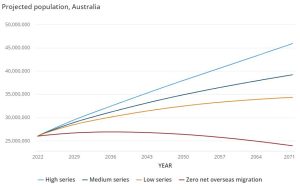Migration generating record population growth – ABS
Australia’s population has just crashed through the 27 million mark, and migration is a major reason why it is accelerating, new data from the Australian Bureau of Statistics (ABS) reveals.
The data shows the jump from 26 to 27 million occurred in March, this year, and took just one-and-three-quarter years, ‘far quicker than the average’.
The ABS says the jump is largely due to post-pandemic overseas migration.
The national population grew by 2.3 per cent to 27.1 million in the year ending 31 March, according to the ABS data.
 ABS demography director Phil Browning said that since 2007, it has grown on average by a million about every two-and-three-quarter years but that the latest jump was “far quicker than the average”.
ABS demography director Phil Browning said that since 2007, it has grown on average by a million about every two-and-three-quarter years but that the latest jump was “far quicker than the average”.
It was also quicker than population growth for the previous milestone of 25 million to 26 million, which took just shy of four years, from September 2018 to June 2022 – a plateau effect of the COVID-era lockdowns.
“Net overseas migration – counting both people who have entered and left Australia – was 509,800 people and students made up a “sizeable chunk,” Mr Browning said.
“That’s down from a peak of 559,900 in September 2023 … but it’s still high,” he said.
Annual natural increase – counting both births and deaths – was 105,500 people.
“Natural increase is not moving a whole lot, and overseas migration is the significant driver,” Browning said.
The total fertility rate sits at about 1.6 births per woman, which Mr Browning described as “historically, fairly low”.
“We don’t know if that will continue or not, but it doesn’t show any signs of going up or down at the moment,” he said.
Every state and territory had positive population growth. Western Australian had the largest, at 3.1 per cent, and Tasmania the lowest, at 0.4 per cent.
The next milestone of 28 million is projected for 2027.
Mr Browning said ABS calculations predict Australia’s population could hit 30 million by the year 2033.
A separate report from the ABS says Australia’s population is projected to reach between 34.3 million and 45.9 million people by 2071 – up from 26 million in 2022.
But without overseas migration, the population will decline, the ABS says.
Overseas migration will be a critical factor in this growth as the birth rate declines in relation to the numbers of people dying.
The ABS modelling charts three potential population growth trajectories – high, medium and low – which deliver varying population growth numbers.
“The current ten-year average annual growth rate (1.4 per cent) is projected to decline to between 0.2 per cent and 0.9 per cent,” the ABS report says.
It says the average age of Aussies will rise by a decade.
“The median age (38.5 years) is projected to increase to between 43.8 and 47.6 years,” the report says.
Australia’s population is set to increase by an annual average of between 1.2 per cent and 1.7 per cent until June 2032 and also grow by an annual average of between 0.6 per cent and 1.1 per cent per year over the entire projection period.
It will reach between 29.2 and 30.8 million people by 2032, and between 34.3 and 45.9 million people by 2071.












